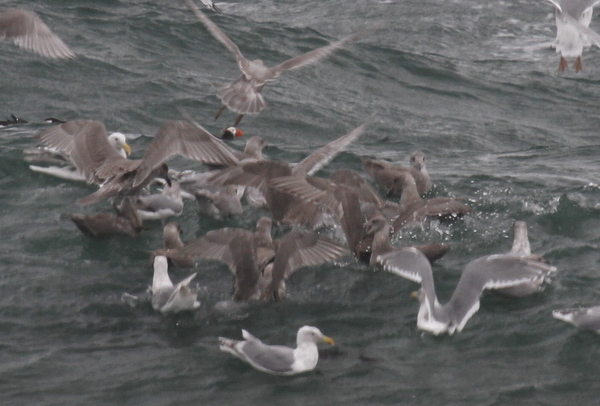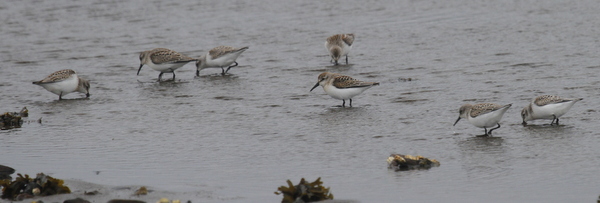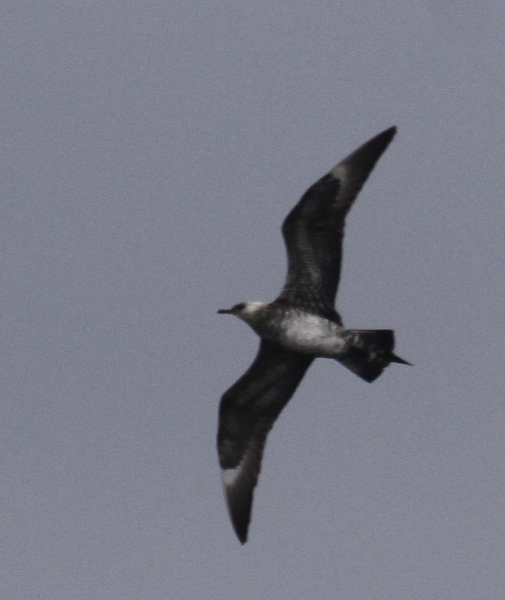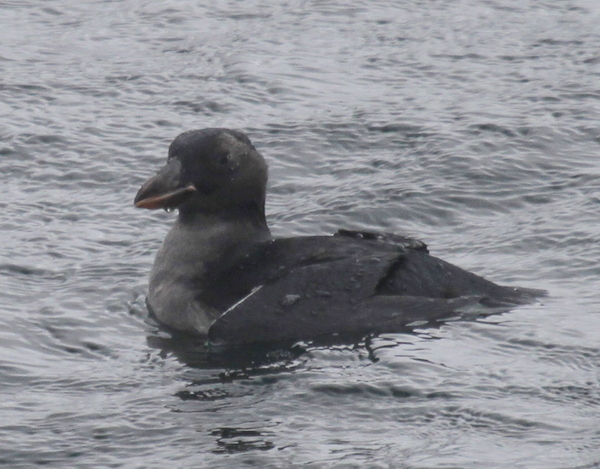The Sanderlings are coming! The Sanderlings are coming!
Or not…
Temp near 50, overcast, on and off (mostly off) light rain, 20-30 mph east winds swinging to NE by late afternoon.
There were few birds out on the bay and in Sweeper Cove this morning due to the high seas and strong wind.
We headed out to Lake Andrew and finally found some Mallards (usually in abundance on Adak).
At the Palisades Overlook, we spotted a few hundred Short-tailed Shearwaters that had blown into the bay.
At Clam Lagoon, I decided not to walk the flats and we continued around to the seawall. With very strong winds and high surf, picking out birds was not easy. We had a Horned Grebe and got a glimpse of a loon which we soon lost in the surf and never did identify to species.
An immature kittiwake caused us some momentary excitement. They are so boldly marked, compared to the adults. We often wonder why 99% of the kittiwakes we see here are adults. Where are the young birds?
There were several feeding frenzies going on with multiple species of birds joining in.
When we came back around the lagoon, we scanned the peninsula and saw a small flock (maybe a dozen) of shorebirds. A flock this size usually indicates Sanderlings, which is a good thing. Our experience in fall has been that when a flock of Sanderlings move in, they stay awhile and tend to attract other shorebirds to join them, leading to some goodies (stints, etc).
They flew up for a few seconds and we noticed a larger shorebird mixed in. So I trudged on out to get a closer look (and photos). When I got out there, they turned out to be Western Sandpipers and one Rock Sandpiper. The most Western Sandpipers that we have ever had on Adak was two! And, according to the Birds of the Aleutians book, they only occur in twos and threes on the islands. So this was a very good record.
We studied the photos carefully when we got back and all ten were westerns–no stints (However, if anyone can say otherwise, please do).
As I was walking back towards Barb and the car, she radioed that she had a light-morph jaeger. Ninety-nine percent of all Parasitic Jaegers that occur on Adak are dark-morph. So the possibility that this was a Pomarine Jaeger instead was very high! Unfortunately, it turned out to be a Parasitic, still a nice bird, but not new for our Adak list.
In addition to the light-morph, there were three dark-morph jaegers. Most jaegers leave Adak by mid-September, so this was a good number.
As we were going down the hill above Navfac Ceek, a bright yellow bird zipped by and behind us. The only regularly-occurring yellow bird on Adak is Yellow Wagtail, which would be a lifer for both of us. However, an hour of searching failed to find it, so it will go down as another coulda-been…
At the Landing Lights bridge, a couple of guys flagged us down and asked for a ride down to the Sweeper Cove jetty. They were hunter/fishermen who had already bagged there Caribous and now were doing some fishing. One was from Hawaii and the other from Idaho. We dropped them off at the end of the jetty and, as we drove back, we spotted an alcid close by. It was an immature Tufted Puffin–much more cooperative than the one we saw last year.
So, not a bad day.





